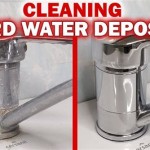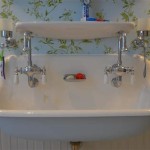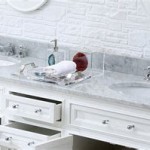Replacing Bathroom Floor Rotted In Kitchen Sink Only Fix
Water damage in a home can manifest in unexpected ways. While a leaking faucet in a bathroom might seem like an isolated issue, it can, in some circumstances, lead to problems elsewhere, particularly if there are interconnected plumbing systems or structural weaknesses. This article addresses the scenario of bathroom floor rot stemming from a leak or plumbing issue solely related to the kitchen sink. It details the diagnostic process, the repair options available, and preventative measures to minimize future occurrences. The complexity of such a situation often necessitates a combined understanding of plumbing, structural integrity, and moisture management.
The initial step in addressing this problem is accurate diagnosis. It is crucial to definitively establish that the bathroom floor rot is, in fact, solely attributable to an issue originating at the kitchen sink. Superficial observation might suggest this connection, but a thorough investigation is paramount. This investigation must involve examining the plumbing runs between the kitchen sink and the affected area of the bathroom floor, looking for pathways for water to travel. These pathways can be hidden behind walls, under floors, or through shared plumbing chases. Consider the age of the home's plumbing system, the materials used (e.g., copper, PVC, galvanized steel), and any previous repairs or modifications. These factors will influence the likelihood of leaks and the potential for water to migrate.
Once the cause is confirmed to originate solely in the kitchen sink area, the focus shifts to addressing the source of the leak. This may involve repairing or replacing the sink drain, supply lines, faucet, or garbage disposal. It's important to meticulously inspect all components for signs of corrosion, cracks, or loose connections. A pressure test of the plumbing system can help identify subtle leaks that might not be immediately apparent. In cases of severe corrosion or outdated plumbing, a complete replacement of the affected section might be the most prudent and cost-effective long-term solution.
Following the repair of the kitchen sink plumbing, the damaged bathroom floor must be addressed. This invariably involves removing the rotted material and assessing the extent of the damage to the subfloor and any supporting joists. The removal process should be carried out with care to avoid further damage to adjacent structures. It is crucial to wear appropriate personal protective equipment (PPE), including gloves, a mask, and eye protection, due to the potential presence of mold and other contaminants. The removed material should be disposed of properly in accordance with local regulations.
The severity of the bathroom floor damage will dictate the scope of the repair. In minor cases, only the surface flooring might require replacement. However, if the rot has penetrated the subfloor or supporting joists, a more extensive repair is necessary. Damaged joists must be reinforced or replaced to ensure the structural integrity of the floor. The new subfloor should be properly fastened to the joists using screws or nails, ensuring a secure and level surface. It's essential to use pressure-treated lumber for any repairs to the subfloor or joists, as this will provide added protection against future moisture damage.
Before installing the new flooring, it's critical to ensure the area is completely dry. This may require the use of dehumidifiers and fans to remove any residual moisture. A moisture meter can be used to verify that the moisture content of the subfloor is within acceptable limits before proceeding. Failing to adequately dry the area can lead to future mold growth and further structural damage.
The choice of replacement flooring material is an important consideration. Materials that are resistant to moisture, such as tile, vinyl, or engineered hardwood, are generally preferable for bathrooms. Solid hardwood should generally be avoided in bathrooms due to its susceptibility to water damage. When installing the new flooring, ensure that it is properly sealed and waterproofed, particularly around the edges and any plumbing fixtures. This will help prevent water from seeping beneath the flooring and causing future problems.
Key Point 1: Confirming the Origin of the Leak
Establishing the kitchen sink as the sole source of the bathroom floor rot is crucial. This requires a methodical approach, starting with a visual inspection of the plumbing runs. Look for signs of water damage, such as stains, discoloration, or mold growth. Pay particular attention to joints, connections, and areas where the plumbing passes through walls or floors. A flashlight and a mirror can be helpful for inspecting hard-to-reach areas. If necessary, remove sections of drywall or flooring to gain better access to the plumbing. A plumber can also use tools like a camera snake to examine the inside of pipes and check for leaks.
Trace the path of the water from the kitchen sink to the bathroom. Consider the layout of the plumbing system and how water could potentially travel from one location to another. Are there any shared plumbing chases or other routes that water could take? Investigate any potential points of entry for water into the bathroom, such as cracks in the walls or floors. If there are multiple bathrooms in the home, check to see if any of them are also experiencing similar problems. This can help rule out other potential sources of the leak.
Document all findings with photographs and notes. This will be helpful for communicating with contractors or insurance companies. If necessary, consult with a qualified plumber or building inspector to obtain a professional opinion. They can provide expert advice and help you determine the best course of action. It is essential to thoroughly document all potential water sources to isolate the problem to the kitchen sink.
Key Point 2: Addressing the Kitchen Sink Plumbing
Once the kitchen sink is identified as the source of the leak, meticulous repair or replacement of the plumbing is essential. Begin by turning off the water supply to the sink. This will prevent water from flowing while you are working on the plumbing. Disconnect the drain and supply lines from the sink. Inspect them carefully for signs of damage, such as cracks, corrosion, or loose connections. The drain often is the source via a slow drip that isn't immediately obvious. If any of these issues are present, replace the affected components with new ones.
Inspect the sink itself for any cracks or leaks. If the sink is cracked or damaged, it may need to be repaired or replaced. Clean the area around the sink and plumbing to remove any dirt or debris. This will make it easier to identify any potential problems. Apply plumber's putty or sealant to any connections to ensure a watertight seal. Tighten all connections securely, but be careful not to overtighten them, as this could damage the plumbing. Use appropriate tools, such as wrenches and pliers, to tighten the connections.
After completing the repairs, turn the water supply back on slowly and check for any leaks. If you find any leaks, tighten the connections further or replace the affected components. Run water through the sink for several minutes to ensure that everything is working properly. Check the drain for any clogs or obstructions. If there are any clogs, use a plunger or drain snake to clear them. Consider installing a new kitchen faucet with improved leak detection capabilities. Regularly inspect the kitchen sink plumbing for any signs of leaks or damage.
Key Point 3: Repairing the Damaged Bathroom Floor
The repair of the bathroom floor necessitates a multi-stage approach. First, remove all rotted flooring materials, including the surface flooring, subfloor, and any damaged joists. Use appropriate tools, such as a pry bar, hammer, and saw, to remove the flooring. Be careful not to damage any adjacent structures. Wear appropriate PPE, including gloves, a mask, and eye protection, to protect yourself from mold and other contaminants. Dispose of the removed materials properly in accordance with local regulations.
Inspect the exposed subfloor and joists for any signs of rot or damage. If the damage is extensive, the subfloor and/or joists may need to be replaced. Reinforce damaged joists by sistering new joists alongside them. Use screws or nails to fasten the new joists to the existing ones. Ensure that the new joists are properly supported and level. Install a new subfloor using pressure-treated lumber. Fasten the subfloor to the joists using screws or nails. Ensure that the subfloor is level and smooth.
Apply a waterproof membrane to the subfloor to prevent future water damage. Install new flooring, such as tile, vinyl, or engineered hardwood. Ensure that the flooring is properly sealed and waterproofed, particularly around the edges and any plumbing fixtures. Caulk any gaps or cracks to prevent water from seeping beneath the flooring. Regularly inspect the bathroom floor for any signs of water damage. Address any leaks or problems promptly to prevent further damage. Consider installing a bathroom fan to improve ventilation and reduce moisture levels.

How To Replace Rotted Wood Under A Kitchen Sink Diy Guide Dengarden

Rotted Sink Cabinet Floor How To Fix

Rotted Sink Cabinet Floor How To Fix

Rotted Sink Cabinet Floor How To Fix

How To Replace Rotted Wood Under A Kitchen Sink Diy Guide Dengarden

Damaged Sink Cabinet Floor How To Fix

Water Damage Bathroom Floor Tips From Professionals And Moisture Expert
When Repairing The Bottom Of Cabinet Below Kitchen Sink Do I Need To Take Damaged Section Out Or Can Simply Put Plywood On Top It Quora

How Do I Repair My Water Damaged Sink Cabinet Hometalk

How To Replace Rotted Wood Under A Kitchen Sink Diy Guide Dengarden
Related Posts







